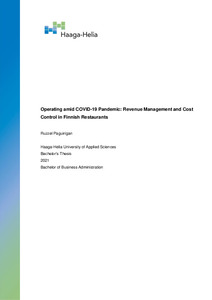Operating amid COVID-19 Pandemic: Revenue Management and Cost Control in Finnish Restaurants
Paguirigan, Ruzzel (2022)
Julkaisun pysyvä osoite on
https://urn.fi/URN:NBN:fi:amk-2022051810331
https://urn.fi/URN:NBN:fi:amk-2022051810331
Tiivistelmä
The COVID-19 pandemic brought particular challenges to the restaurant industry in Finland. The challenges included were government-imposed actions like two closures, restrictions on the opening hours, limited seating capacity, and requirements for restaurants when operating during the pandemic. Restaurants had a restricted operating environment and fluctuating customer demand, causing difficulties with the usual operating practices. These led to the research question, “How did restaurants manage their operational activities during the COVID-19 pandemic?”.
This qualitative research had five investigative questions that led to the research question of this study. The research underwent two phases using primary data and secondary data. The first phase used a purposive homogeneous sampling strategy for its semi-structured interviews. The criteria were that all interviewees were on the same level of authority for a restaurant established before 2020, located in Helsinki, Finland. Altogether, the author interviewed five restaurant owners/co-owners/CEOs from November to December 2021. In the second phase, the secondary data collected were from NoHo Partners Plc’s annual reports and financial statements for 2020 and 2021. The primary and secondary data were analyzed using the qualitative content analysis method, specifically latent content analysis.
The study found out that the challenges significantly impacted the restaurants’ sales and changed the customers’ behavior towards dining and takeaways. Owners took drastic actions to stop/minimize cash outflows and secure enough cash for reopening and future growth while improving their revenue management to maximize and increase their revenue. Restaurants became better at managing their restaurant and realized their importance because of the COVID-19 pandemic. Takeaways through food transport services became a phenomenon in the restaurant industry. However, restaurants had mixed opinions on these services. The Government and other entities offered support to the affected restaurants; however, small restaurants found it hard to get Government support because of the criteria. These findings were in line with the first and the second phase findings.
Different factors influenced the impact on business operations. The fluctuations in demand and Government actions negatively impacted the restaurants’ sales and growth. At the same time, external factors such as the location, type of restaurant, and reputation affected the demand for dining and takeaway orders during the pandemic. It was also crucial for the restaurants to monitor and control costs and have good operational, fiscal, and supply chain management skills.
This qualitative research had five investigative questions that led to the research question of this study. The research underwent two phases using primary data and secondary data. The first phase used a purposive homogeneous sampling strategy for its semi-structured interviews. The criteria were that all interviewees were on the same level of authority for a restaurant established before 2020, located in Helsinki, Finland. Altogether, the author interviewed five restaurant owners/co-owners/CEOs from November to December 2021. In the second phase, the secondary data collected were from NoHo Partners Plc’s annual reports and financial statements for 2020 and 2021. The primary and secondary data were analyzed using the qualitative content analysis method, specifically latent content analysis.
The study found out that the challenges significantly impacted the restaurants’ sales and changed the customers’ behavior towards dining and takeaways. Owners took drastic actions to stop/minimize cash outflows and secure enough cash for reopening and future growth while improving their revenue management to maximize and increase their revenue. Restaurants became better at managing their restaurant and realized their importance because of the COVID-19 pandemic. Takeaways through food transport services became a phenomenon in the restaurant industry. However, restaurants had mixed opinions on these services. The Government and other entities offered support to the affected restaurants; however, small restaurants found it hard to get Government support because of the criteria. These findings were in line with the first and the second phase findings.
Different factors influenced the impact on business operations. The fluctuations in demand and Government actions negatively impacted the restaurants’ sales and growth. At the same time, external factors such as the location, type of restaurant, and reputation affected the demand for dining and takeaway orders during the pandemic. It was also crucial for the restaurants to monitor and control costs and have good operational, fiscal, and supply chain management skills.
